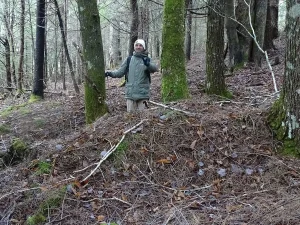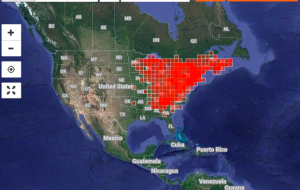A study of the origin of Hemlock forests in southwestern Nova Scotia
M. Miles, E. Smith Published 1 December 1960 in Forestry Chronicle (Full PDF available) “ABSTRACT A study of neighboring forest stands seventy, one hundred and fifty, and three hundred years old was made in the hemlock area of southwestern Nova Scotia. Soils, drainage and climate were similar. Evidence pointed to fire as the agent in the removal of the original forest in the case of the two younger stands. The number of short-lived trees decreased with the age of the stand, and the abundance and distribution of hemlock indicated its ultimate dominant position. From trends apparent in the younger stands, it appears that having reached an age of three hundred years their composition will be similar to the present composition of the three hundred year old stand. It is concluded that fire may play a major role in the initiation of the development of pure hemlock stands.”

Pit and Mound topography in Old Growth hemlock/yellow birch forest by Sandy Lake (Bedford, NS).
Click on images for larger versions
Comment: At the time this paper was written, the significance of hurricanes as a major agent of forest disturbance in NS was not well recognized – there is only one reference to “wind”, 23 to “fire”. It’s quite possible that some of the stand-initiating events Miles and Smith thought to be related to historical fire were in fact related to hurricane disturbance or hurricane disturbance followed by fire. Pit and mound topography is pronounced in many old hemlock stands in NS, e.g. at Sandy Lake (Bedford, NS). (Currently, there seem to be no formally published observations of this nature for NS).
On Eastern Hemlock in N.A, and N.S. From the Intro: “Nova Scotia is placed within the Hemlock – White Pine -Northern Hardwood Forest Region by Nichols (22). This region, although transitional between the boreal forest to the north and the deciduous forest to the south, contains species which are more or less confined to it, and which give the region an ecological distinctness (22, 1). These characteristic species are hemlock (Tsuga canadensis (L.) Carr.), red spruce (Picea rubens Sarg.), white pine (Pinus Strobus L.) and yellow birch (Betula lutea Michx. f.). Rowe (24) included most of the Maritime Provinces within the Acadian Forest Region, which corresponds approximately to the eastern part of the Hemlock -White Pine – Northern Hardwood Region of Nichols.
“The Nova Scotian portion of the Acadian Forest Region is divided into seven sections. The Tobeatic Area of Queens County where the present study was carried out is located within the Atlantic Uplands Section which covers more than one half of the area of the province. The forest, primarily coniferous, includes a large proportion of hemlock, and red spruce. White and red pine (Pinus resinosa Ait.) and red maple (Acer rzibrum L.) are frequently found, while balsam fir (Abies balsamea (L.) Mill.) is present as a minor constitueat in mature stands. Pioneer species such as white birch (Betula papyrifera Marsh.), red maple, large-tooth aspen (Populus grandidentata Michx.) are commonly found in disturbed areas. Northern red oak (Quercus rubra L., var. borealis (Michx. f.) Farw.) and other deciduous species are prominent in some areas, but the general aspect is that of a coniferous forest.
“Hemlock occurs in varying amounts throughout the province of Nova
Scotia. In Cape Breton Island and in the northeastern portion of the mainland it is relatively rare, occurring mainly mixed with deciduous species on the slopes of ravines and in brook valleys. The species becomes more common toward the southwest, where it occurs in extensive pure stands or mixed with red spruce. The abundance of hemlock in the latter area was reported as early as 1801 by Titus Smith (26). In 1952 Drinkwater (6) estimated that pure stands of hemlock covered approximately 45,000 acres in this region.”
On occurrence of pure, even aged stands
“The characteristic forest of the region in which Nova Scotia occurs is a mixed forest in which even-aged stands of one species are not typical. The suggestions which have been advanced to explain the origin of pure, evenaged stands of hemlock are varied and sometimes conflicting.” The paper attepmts to explain the occurrence of such stands in SW Nova Scotia, see discussion section for review of related info on the ecology of E. Hemlock.

